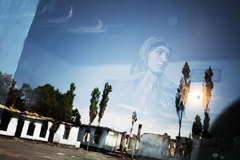Kirghizstan : Fragile démocratie
This post is also available in:
 French
French
I remember becoming conscious of Kyrgyzstan for the first time when in march 2005 I watched on TV Asiatic looking men surging toward an imposing soviet-style administrative building. Once inside the building they started to vandalise and loot anything they found and soon after a few men appeared on the roof of the building, brandishing a flag.
This event became known as the “tulip revolution” and the press reported that the Kyrgyz people, motivated by social injustice, had overthrown the authoritarian and corrupt regime of president Askar Akayev and replaced him with Kurmanbek Bakiyev.It was a few years later, with the country removed from the limelight and forgotten, that I visited Kyrgyzstan for the first time. I set out to discover what the tulip “revolution”, which was supposed to have lead to a “democratic transition in the country”, had really accomplished. This so-called revolution seemed to have been no more than a power grab. The elections were still rigged, some media were censured, political opponents were being arrested and Kyrgyzstan was considered one of the 15 most corrupt countries in the world. Even today, 40% of the population live below the poverty line and many look back to the soviet era with nostalgia. Today people speaks of the tulip revolution as a coup d’etat disguised as a popular revolution.I continued to visit the country over the course of several trips. I was struck by the growing instability there which eventually lead to the bloody riots of April 2010. This was a new revolution, perhaps a little more authentic this time. The nepotistic Bakiyev was overthrown in his turn and found refuge in Belarus, as Akayev had five years earlier. There followed a period of great unrest during which Osh, the major city in the south, was the scene of ethnic clashes. Officially, around 500 people were killed. In truth, the numbers are probably much higher. 400 000 people, mainly ethnic Uzbeks, were displaced from their homes. Some say the young country never really recovered from the USSR collapse in 1991 and that what it experiences now would be the paintfull learning of independance.William Daniels
From 19/09/2012 to 27/10/2012
Galerie FAIT & CAUSE
58 rue Quincampoix
75004 Paris
France
Opening hours : Du mardi au samedi de 13h30 à 18H30
Phone : + 33 (0)1 42 74 26 36
contact@sophot.com
www.sophot.com



